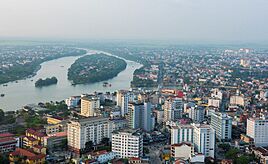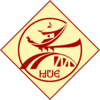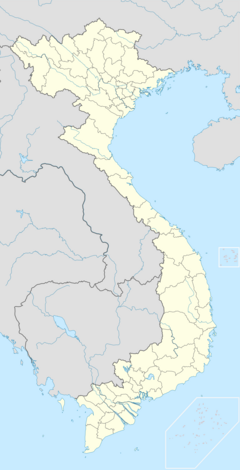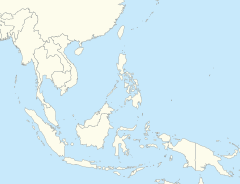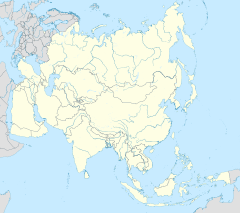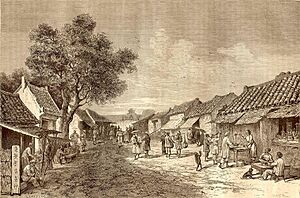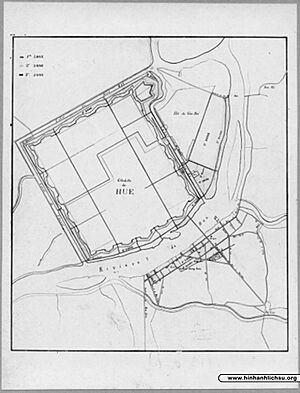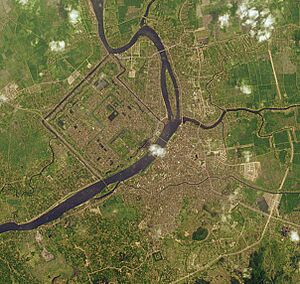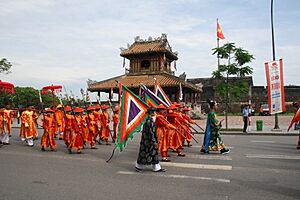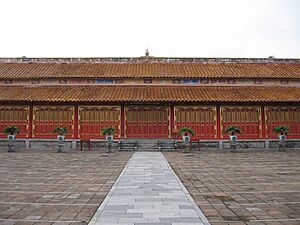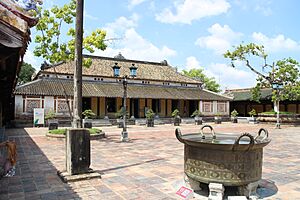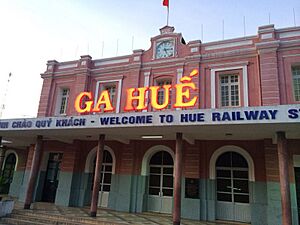Huế facts for kids
Quick facts for kids
Huế
Thành phố Huế
Phú Xuân
|
||
|---|---|---|
| City of Huế | ||
|
Aerial view of Hue
Meridian Gate
Thiên Mụ Temple
Trường Tiền Bridge
|
||
|
||
| Nickname(s):
City of Romance, Festival City
|
||
| Country | ||
| Region | North Central Coast | |
| Area | ||
| • Total | 265.99 km2 (102.70 sq mi) | |
| Elevation | 15 m (49 ft) | |
| Population
(2020)
|
||
| • Total | 652,572 | |
| • Density | 2,453/km2 (6,350/sq mi) | |
| Metro GDP (PPP, constant 2015 values) | ||
| • Year | 2023 | |
| • Total | $3.8 billion | |
| • Per capita | $8,900 | |
| Climate | Am | |
| Website | www.huecity.gov.vn | |
Huế is a historic city located in central Vietnam. It is the capital of Thừa Thiên Huế province and sits near the Perfume River. Huế was once the capital of the ancient Champa Kingdom and later became the capital of Vietnam for a long time.
From 1802 to 1945, Huế was the capital city for the Nguyễn dynasty, Vietnam's last royal family. It was also the administrative center during the French Indochina period. Today, Huế is famous for its many old buildings and monuments. These include the Imperial City of Huế, with its palaces and temples, and the Forbidden Purple City, which was once the emperor's private home.
Many of these historic sites are part of the Complex of Huế Monuments, a UNESCO World Heritage Site. This means they are very important and protected. In 2019, nearly 4.2 million people visited Huế to see its amazing history. Many of the old buildings are still being carefully restored.
Contents
History of Huế
The earliest signs of a city in Huế date back to the 4th century AD. These ruins belonged to the Kingdom of Lâm Ấp. The ancient city of Kandarpapura, which was the capital of Lâm Ấp, is now found on Long Tho Hill, west of modern Huế. Another old Cham city called Hoa Chau in the area dates back to the 9th century.
Becoming Part of Vietnam
In 1306, the King of Champa, Che Man, gave two areas, Ô and Lý, to Vietnam. This was in exchange for marrying a Vietnamese princess named Huyền Trân. The Vietnamese King Trần Anh Tông accepted this offer. He renamed these areas Thuan and Hóa, and together they were known as the Thuận Hóa region.
The Nguyễn Lords and Civil War
In 1592, the Mạc dynasty lost power, and the Lê dynasty was put back in charge. However, the real power was held by different families. One of these was the Nguyễn family. Nguyễn Hoàng, a leader of the Nguyễn family, was given permission to govern the Thuận Hóa region in the south.
Nguyễn Hoàng and his son, Nguyễn Phúc Nguyên, made this southern region loyal to their family. They then went against the Trịnh lords, another powerful family in the north. This started a long civil war in Vietnam between the Nguyễn lords and the Trịnh lords.
The Nguyễn lords chose Thừa Thiên, a northern part of Thuận Hóa, as their main base. In 1687, they began building a citadel (a type of fortress) in Phú Xuân, which later became Huế. This citadel was a symbol of their power. In 1744, Phú Xuân officially became the capital of central and southern Vietnam.
Huế as the Imperial Capital
In 1771, the Tây Sơn rebellion began, which weakened the Nguyễn lords. The Trịnh lords then captured Phú Xuân in 1775. Later, the Tây Sơn rebels defeated the Trịnh army and took over Phú Xuân in 1786. Under Emperor Quang Trung, Phú Xuân became the capital of the Tây Sơn dynasty.
In 1802, Nguyễn Ánh, a successor of the Nguyễn lords, recaptured Phú Xuân. He unified the entire country and rebuilt the citadel, making it the Imperial City capital of all Vietnam. He became Emperor Gia Long, the first emperor of the Nguyễn dynasty.
The second Nguyễn emperor, Minh Mạng, ruled from Huế from 1820 to 1841. He was known for not wanting French influence in Vietnam.
During the French colonial period, Huế remained the seat of the Imperial Palace until 1945. That year, Emperor Bảo Đại gave up his throne, and the new government of Vietnam was set up with its capital in Hanoi.
The Vietnam War and Restoration
Huế was very close to the border between North and South Vietnam during the Vietnam War. In 1968, the city was a major battleground during the Tet Offensive. This event, known as the Battle of Huế, caused a lot of damage to the city's historic buildings.
After the war ended in 1975, many of Huế's historic sites were not taken care of. Some people saw them as symbols of the old royal system. However, this policy changed, and now many historical areas are being restored. Huế is growing as a center for tourism and transportation in central Vietnam.
Geography of Huế
Huế is located in central Vietnam, right on the banks of the Hương River, also known as the Perfume River. It's only a few miles inland from the East Sea. The city is about 700 kilometers (435 miles) south of Hanoi and about 1,100 kilometers (684 miles) north of Ho Chi Minh City.
The city's total area is about 265.99 square kilometers (102.70 square miles). In 2021, its population was around 652,572 people. Huế is a flat area, about 3–4 meters (10–13 feet) above sea level. It can sometimes flood when the Perfume River has heavy rainfall. There are also some low hills and mountains nearby, like Ngự Bình mountain.
Climate in Huế
Huế has a tropical monsoon climate. This means it has a wet season and a dry season. The dry season lasts from February to August, with very hot temperatures, often reaching 35 to 40°C (95 to 104°F).
The rainy season is from August to January. During this time, there can be floods, especially from October onwards. The average temperature in the rainy season is around 20°C (68°F), but it can sometimes drop to 9.5°C (49.1°F). The highest temperature ever recorded was 42.2°C (108°F) in April 2024, and the lowest was 8.8°C (47.8°F) in January 1934.
| Climate data for Huế | |||||||||||||
|---|---|---|---|---|---|---|---|---|---|---|---|---|---|
| Month | Jan | Feb | Mar | Apr | May | Jun | Jul | Aug | Sep | Oct | Nov | Dec | Year |
| Record high °C (°F) | 34.6 (94.3) |
36.3 (97.3) |
38.6 (101.5) |
42.2 (108.0) |
42.1 (107.8) |
40.7 (105.3) |
40.2 (104.4) |
40.2 (104.4) |
39.7 (103.5) |
36.1 (97.0) |
35.4 (95.7) |
32.2 (90.0) |
42.2 (108.0) |
| Mean daily maximum °C (°F) | 23.5 (74.3) |
24.5 (76.1) |
27.5 (81.5) |
31.1 (88.0) |
33.5 (92.3) |
34.7 (94.5) |
34.7 (94.5) |
34.2 (93.6) |
31.7 (89.1) |
29.0 (84.2) |
26.5 (79.7) |
23.8 (74.8) |
29.6 (85.3) |
| Daily mean °C (°F) | 19.9 (67.8) |
20.8 (69.4) |
23.1 (73.6) |
26.1 (79.0) |
28.2 (82.8) |
29.3 (84.7) |
29.2 (84.6) |
28.8 (83.8) |
27.1 (80.8) |
25.3 (77.5) |
23.2 (73.8) |
20.7 (69.3) |
25.1 (77.2) |
| Mean daily minimum °C (°F) | 17.5 (63.5) |
18.2 (64.8) |
20.2 (68.4) |
22.7 (72.9) |
24.5 (76.1) |
25.3 (77.5) |
25.2 (77.4) |
25.1 (77.2) |
24.1 (75.4) |
22.8 (73.0) |
21.0 (69.8) |
18.6 (65.5) |
22.1 (71.8) |
| Record low °C (°F) | 8.8 (47.8) |
9.5 (49.1) |
10.7 (51.3) |
14.1 (57.4) |
17.7 (63.9) |
20.5 (68.9) |
19.8 (67.6) |
21.0 (69.8) |
19.1 (66.4) |
15.9 (60.6) |
12.9 (55.2) |
9.5 (49.1) |
8.8 (47.8) |
| Average rainfall mm (inches) | 129.3 (5.09) |
63.3 (2.49) |
51.3 (2.02) |
58.9 (2.32) |
111.3 (4.38) |
103.4 (4.07) |
94.6 (3.72) |
138.8 (5.46) |
410.7 (16.17) |
772.7 (30.42) |
641.7 (25.26) |
349.9 (13.78) |
2,936.4 (115.61) |
| Average rainy days | 15.5 | 11.6 | 10.2 | 9.2 | 11.7 | 9.3 | 8.5 | 10.7 | 16.3 | 20.8 | 20.9 | 20.2 | 165.1 |
| Average relative humidity (%) | 89.6 | 89.9 | 87.8 | 84.1 | 79.1 | 75.4 | 74.1 | 76.4 | 83.6 | 87.7 | 89.1 | 90.2 | 83.9 |
| Mean monthly sunshine hours | 104.0 | 110.3 | 140.8 | 175.9 | 230.9 | 232.5 | 236.7 | 209.9 | 169.2 | 130.6 | 101.2 | 76.0 | 1,916.1 |
| Source 1: Vietnam Institute for Building Science and Technology | |||||||||||||
| Source 2: The Yearbook of Indochina | |||||||||||||
| Month | Jan | Feb | Mar | Apr | May | Jun | Jul | Aug | Sep | Oct | Nov | Dec | Year |
|---|---|---|---|---|---|---|---|---|---|---|---|---|---|
| Average temperature °C (°F) | 24 °C (75 °F) | 23 °C (73 °F) | 24 °C (75 °F) | 26 °C (79 °F) | 28 °C (82 °F) | 30 °C (86 °F) | 30 °C (86 °F) | 30 °C (86 °F) | 29 °C (84 °F) | 28 °C (82 °F) | 27 °C (81 °F) | 25 °C (77 °F) | 27 °C (81 °F) |
Culture in Huế
Huế was the royal capital of Vietnam for about 150 years. Because of this, the royal way of life and traditions greatly influenced the people of Huế. You can still see this influence today.
Name-giving Traditions
The royal family had special customs for naming their children. These customs were later adopted by many people in Huế. Royal family members were named using a poem written by Minh Mạng, the second emperor of the Nguyễn dynasty.
This poem, "Đế hệ thi", helped people know the family order and relationships between royal members. The names also reflected important personality traits the royal family wanted their children to have. This tradition is still followed by many people from Huế's royal family branches today.
Traditional Clothing
The modern áo dài, which is Vietnam's national costume, developed from clothes worn by people in central Vietnam in the 18th century. This happened after a clothing reform by Lord Nguyễn Phúc Khoát.
This outfit later became the áo ngũ thân, a five-part costume popular in the 19th and early 20th centuries. Artists in Hanoi redesigned the ngũ thân to create the modern áo dài in the 1920s and 1930s.
While the áo dài and nón lá (conical hat) are symbols of Vietnam, they are especially connected to Huế. Violet-colored áo dài are very common in Huế. This color has a special link to the city's history as a former capital.
Delicious Cuisine
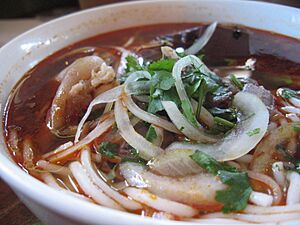
The food in Huế is a very important part of Central Vietnamese cuisine. One unique thing about Huế is how popular vegetarian food is. Many vegetarian restaurants are found throughout the city. Locals often eat vegetarian meals twice a month as part of their Buddhist beliefs.
Huế dishes are known for being served in smaller portions and looking very beautiful. This comes from its royal cuisine, which was made to please emperors and their families. Huế food is also often very spicy!
Huế cuisine includes both fancy royal dishes and simple, popular ones. Here are some famous dishes:
- Bún bò Huế is a spicy beef noodle soup.
- Bánh bèo is a Vietnamese dish from Huế. It's made from rice flour and tapioca flour, topped with dried shrimp and crispy pork skin. It's a popular street food for lunch or dinner.
- Cơm hến (baby basket clams rice) is a Huế dish made with small mussels or clams and rice. It's usually served at room temperature.
- Bánh ướt thịt nướng (steamed rice pancake with grilled pork) is a well-known dish from Kim Long-Huế. It includes steamed rice pancakes, fresh herbs, grilled pork, and a dipping sauce.
- Bánh khoái (Huế shrimp and vegetable pancake) is a deep-fried pancake similar to Bánh xèo. It's served with a special Huế peanut dipping sauce that contains pork liver.
- Bánh bột lọc (Vietnamese clear shrimp and pork dumplings) are made with tapioca flour, shrimp, and pork belly. They can be wrapped in banana leaves and are served with sweet chili fish sauce.
- Banh it ram (fried sticky rice dumpling) is a Central Vietnamese specialty. It combines a soft, chewy sticky rice dumpling with a crispy sticky rice cake.
Huế is also famous for its delicious sweet desserts. These include sweet soups made with lotus seeds, or lotus seeds wrapped in logan fruit, and various other unique sweet treats.
Religion and Beliefs
The royal court in Huế practiced different religions, like Buddhism, Taoism, and Confucianism. The most important place for worship was the Esplanade of Sacrifice to the Heaven and Earth. Here, the emperor would pray to Heaven and Earth every year.
Buddhism was especially strong in Huế, more so than in other parts of Vietnam. The city had many monasteries and was home to some of the country's most famous monks. Thích Nhất Hạnh, a world-famous Zen master, was from Huế. He returned to his hometown in 2018 and lived at the Tu Hieu pagoda until he passed away in 2022.
Tourism in Huế
| UNESCO World Heritage Site | |
|---|---|
| Criteria | Cultural: iv |
| Inscription | 1993 (17th Session) |
| Area | 315.47 ha |
| Buffer zone | 71.93 ha |
Huế is well known for its many historic monuments. These sites are so important that UNESCO has listed them as World Heritage Sites. The main area for the Nguyễn emperors was the Imperial City. This is a large, walled area on the north side of the Perfume River.
Inside the Imperial City was a special area called the Forbidden Purple City. Only the emperors, their wives, and close family were allowed inside. Anyone else who entered could face severe punishment. Today, not much of the Forbidden Purple City remains, but efforts are being made to rebuild parts of it for tourists.
Along the Perfume River, you can find many other important monuments. These include the tombs of several emperors, such as Minh Mạng, Khải Định, and Tự Đức. The Thiên Mụ Temple is also a famous site. It is the largest pagoda in Huế and is considered an official symbol of the city.
On the south bank of the Perfume River, there are several buildings built in a French style. These include Hue High School for the Gifted, which is the oldest high school in Vietnam.
The Huế Museum of Royal Fine Arts also has a collection of many historical items from the city. Besides the attractions in Huế itself, you can take day trips to the Demilitarized Zone (DMZ), about 70 kilometers (43 miles) north. Here, you can see old war sites like The Rockpile and the Vịnh Mốc tunnels.
Most hotels, bars, and restaurants for tourists are located in the Pham Ngu Lao, Chu Van An, and Vo Thi Sau streets. These streets form the main area for backpackers and visitors. Tourism is very important for Huế's economy. In the first 11 months of 2012, Huế welcomed 2.4 million visitors. This shows how popular the city is becoming.
Transportation in Huế
Huế has a railway station that connects it to other major Vietnamese cities. This is part of the North–South railway line. The Phu Bai International Airport is located just south of the city center, making it easy for people to fly in and out of Huế.
Sister cities
- Bandar-e Anzali, Iran
- Honolulu, Hawaii, United States
- New Haven, Connecticut, United States
- Blois, France, Centre-Val de Loire, since May 2007
- Phra Nakhon Si Ayutthaya province, Thailand
Images for kids
See also
 In Spanish: Huế para niños
In Spanish: Huế para niños


